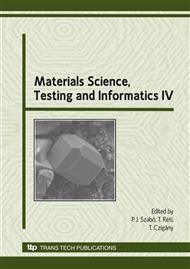p.361
p.367
p.373
p.379
p.385
p.391
p.397
p.403
p.409
Surface Analysis after Shot Peening Processing of ENAW 7075 Aluminium
Abstract:
Shot peening has been a very important and well-known surface cold-hardening process applicable to various machine parts and tool surfaces for quite a long time since it improves fatigue strength and corrosion resistance of stressed surfaces. Hardening by shot peening provides, because of plastic deformation, an increase in hardness and induces compressive residual stresses in the thin surface layer, which reduces material fatigue and prevents the generation and propagation of cracks. The present paper reports of results of shot peening hardening of specimens made of 7075-T651 aluminium. They were surface-hardened by steel shots M170 with Almen hardening intensity of 8A and 12A respectively and by glass beads GP165 with Almen hardening intensity of 12A. The steel shots and glass beads had the same diameter but differed considerably in hardness and density. The surface condition after shot peening processing was assessed in terms of surface integrity, which establishes a relation between processing conditions and roughness state and hardened-layer depth supported by an analysis of residual-stress variations.
Info:
Periodical:
Pages:
385-390
Citation:
Online since:
June 2008
Authors:
Keywords:
Price:
Сopyright:
© 2008 Trans Tech Publications Ltd. All Rights Reserved
Share:
Citation:


